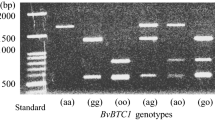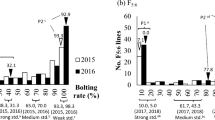Abstract
Key message
This study reveals for the first time a major QTL for post-winter bolting resistance in sugar beet ( Beta vulgaris L.). The knowledge of this QTL is a major contribution towards the development of a winter sugar beet with controlled bolting behavior.
Abstract
In cool temperate climates, sugar beets are currently grown as a spring crop. They are sown in spring and harvested in autumn. Growing sugar beet as a winter crop with an extended vegetation period fails due to bolting after winter. Bolting after winter might be controlled by accumulating genes for post-winter bolting resistance. Previously, we had observed in field experiments a low post-winter bolting rate of 0.5 for sugar beet accession BETA 1773. This accession was crossed with a biennial sugar beet with regular bolting behavior to develop a F3 mapping population. The population was grown in the greenhouse, exposed to artificial cold treatment for 16 weeks and transplanted to the field. Bolting was recorded twice a week from May until October. Post-winter bolting behavior was assessed by two different factors, bolting delay (determined as days to bolt after cold treatment) and post-winter bolting resistance (bolting rate after winter). For days to bolt, means of F3 families ranged from 25 to 164 days while for bolting rate F3 families ranged from 0 to 1. For each factor one QTL explaining about 65 % of the phenotypic variation was mapped to the same region on linkage group 9 with a partially recessive allele increasing bolting delay and post-winter bolting resistance. The results are discussed in relation to the potential use of marker-assisted breeding of winter sugar beets with controlled bolting.



Similar content being viewed by others
References
Abegg F (1936) A genetic factor for the annual habit in beets and linkage relationships. J Agric Res 53:493–511
Abou-Elwafa SF, Buttner B, Kopisch-Obuch FJ, Jung C, Muller AE (2012) Genetic identification of a novel bolting locus in Beta vulgaris which promotes annuality independently of the bolting gene B. Mol Breed 29:989–998
Bachmann L, Curth P, Röstel HJ (1963) Untersuchungen über Gibberellin-Verabreichung in verschiedenen Wachstumsphasen der Beta-Rüben. Theor Appl Genet 33:50–57
Barzen E, Mechelke W, Ritter E, Seitzer JF, Salamini F (1992) RFLP markers for sugar beet breeding: chromosomal linkage maps and location of major genes for rhizomania resistance, monogermy and hypocotyl colour. Plant J 2:601–611
Bauer AB (1932) Beta Hivernalis. Beiträge zu den Versuchen des Prof. Németh mit winterbeständigen Rüben in Ungarn. Fortschritte der Landwirtschaft 7:1–4
Beavis WD (1998) QTL analyses: power, precision and accuracy. In: Paterson AH (ed) Molecular analysis of complex traits. CRC Press, Boca raton, pp 145–161
Biancardi E, Campell LG, Skaracis GN, De Biaggi M (eds) (2005) Genetics and breeding of sugar beet. Science Publishers Inc, Enfield
Boudry P, Wieber R, Saumitou-Laprade P, Pillen K, Dijk H, Jung C (1994) Identification of RFLP markers closely linked to the bolting gene B and their significance for the study of the annual habit in beets (Beta vulgaris L.). Theor Appl Genet 88:852–858
Büttner B, Abou-Elwafa S, Zhang W, Jung C, Müller A (2010) A survey of EMS-induced biennial Beta vulgaris mutants reveals a novel bolting locus which is unlinked to the bolting gene B. Theor Appl Genet 121:1117–1131
Chiurugwi T, Holmes HF, Qi A, Chia TYP, Hedden P, Mutasa-Gottgens ES (2013) Development of new quantitative physiological and molecular breeding parameters based on the sugar-beet vernalization intensity model. J Agr Sci 151:492–505
Claus E (1937) Die Züchtung einer schosswiderstandsfähigen Zuckerrübe. Die deutsche Zuckerindustrie 62(243–244):263–264
Curth P (1962) Special Investigations on Vernalisation and Photoperiodicity of Sugar Beet. Zeitschrift fur Pflanzenzuechtung-Journal of Plant Breeding 47:254
Doerge RW (2002) Mapping and analysis of quantitative trait loci in experimental populations. Nat Rev Genet 3:43–52
Driessen S (2003) Beta vulgaris subsp. maritima an Deutschlands Ostseeküste. Fakultät für Mathematik, Informatik und Naturwissenschaften. Rheinisch-Westfälische Technische Hochschule, Aachen
Eichholz W, Röstel HJ (1962) Züchtung der Winterzuckerrübe. Theor Appl Genet 32:281–290
El-Mezawy A, Dreyer F, Jacobs G, Jung C (2002) High resolution mapping of the bolting gene B of sugar beet. Theor Appl Genet 105:100–105
Esteban Baselga JA (1999) Charactérisation de la betterave de semis d’automne. Proc. IIRB, Sevilla, pp 1–8
FAO (2012) FAOSTAT. http://faostat.fao.org. Accessed 10 Jan 2014
Gusta LV, Wisniewski M (2013) Understanding plant cold hardiness: an opinion. Physiol Plant 147:4–14
Hallauer AR, Carena MJ, Filho JBM (1988) Quantitative genetics in maize breeding, Vol. 6. In: Handbook of plant breeding. Iowa State University Press, Oxford
Hoffmann CM, Kluge-Severin S (2010) Light absorption and radiation use efficiency of autumn and spring sown sugar beets. Field Crops Res 119:238–244
Hohmann U, Jacobs G, Jung C (2005) An EMS mutagenesis protocol for sugar beet and isolation of non-bolting mutants. Plant Breed 124:317–321
IPK (2006) GBIS/I—Genebank Information System of the Institute of Plant Genetics and Crop Plant Research Gatersleben. http://gbis.ipk-gatersleben.de. Accessed 17 Jan 2014
Jaggard KW, Qi A, Ober ES (2009) Capture and use of solar radiation, water, and nitrogen by sugar beet (Beta vulgaris L.). J Exp Bot 60:1919–1925
JKI (2012) International Database for Beta—(IDBB) (Online Database). http://idbb.jki.bund.de. Accessed 22 Jan 2014
Jonsson BO (1999) Development of a winter beet alternative for South Europe. In: Proceedings of IIRB, Sevilla, pp 69–76
Jung C, Müller A (2009) Flowering time control and applications in plant breeding. Trends Plant Sci 14:563–573
Kirchhoff M, Svirshchevskaya A, Hoffmann C, Schechert A, Jung C, Kopisch-Obuch FJ (2012) High degree of genetic variation of winter hardiness in a panel of Beta vulgaris L. Crop Sci 52:179–188
Kosambi DD (1943) The estimation of map distances from recombination values. Ann Eugen 12:172–175
Lasa JM, Medina B (1978) Multiplication of bolting resistant sugar-beet (Beta vulgaris L.). Anales de la Estacion Experimental de Aula Dei 14:163–172
Laurent V, Devaux P, Thiel T, Viard F, Mielordt S, Touzet P, Quillet M (2007) Comparative effectiveness of sugar beet microsatellite markers isolated from genomic libraries and GenBank ESTs to map the sugar beet genome. Theor Appl Genet 115:793–805
Lein JC, Sagstetter CM, Schulte D, Thurau T, Varrelmann M, Saal B, Koch G, Borchardt DC, Jung C (2008) Mapping of rhizoctonia root rot resistance genes in sugar beet using pathogen response-related sequences as molecular markers. Plant Breed 127:602–611
Lexander K (1980) Present knowledge of sugar beet bolting mechanisms. In: 43th Winter Congress of the Institut International de Recherches Betteravieres, Brussels, pp 245–258
Lexander K (1987) Characters related to the vernalization requirement of sugar beet. In: Manipulation of flowering. Butterworths, London, pp 147–158
McFarlane JS, Price C, Owen FV (1948) Strains of sugar beets extremely resistant to bolting. Proc Am Soc Sugar Beet Technol 5:151–153
McGarry RC, Ayre BG (2012) Geminivirus-mediated delivery of florigen promotes determinate growth in aerial organs and uncouples flowering from photoperiod in cotton. PLoS One 7:e36746
McGrath JM, Trebbi D, Fenwick A, Panella L, Schulz B, Laurent V, Barnes S, Murray SC (2007) An open-source first-generation molecular genetic map from a sugarbeet × table beet cross and its extension to physical mapping. Crop Sci 47:S-27
Meier U (2001) Phenological growth stages and BBCH-identification keys of beet. In: Growth stages of mono- and dicotyledonous plants. BBCH Monograph, Federal Biological Research Center for Agriculture and Forestry, Germany
Milford GFJ, Jarvis PJ, Walters C (2010) A vernalization-intensity model to predict bolting in sugar beet. J Agric Sci 148:127–137
Mutasa-Goettgens E, Qi AM, Mathews A, Thomas S, Phillips A, Hedden P (2009) Modification of gibberellin signalling (metabolism & signal transduction) in sugar beet: analysis of potential targets for crop improvement. Transgenic Res 18:301–308
Pin PA, Nilsson O (2012) The multifaceted roles of FLOWERING LOCUS T in plant development. Plant Cell Environ 35:1742–1755
Pin PA, Benlloch R, Bonnet D, Wremerth-Weich E, Kraft T, Gielen JJL, Nilsson O (2010) An antagonistic pair of FT homologs mediates the control of flowering time in sugar beet. Science 330:1397–1400
Pin PA, Zhang W, Vogt SH, Dally N, Buettner B, Schulze-Buxloh G, Jelly NS, Chia TYP, Mutasa-Goettgens ES, Dohm JC, Himmelbauer H, Weisshaar B, Kraus J, Gielen JJL, Lommel M, Weyens G, Wahl B, Schechert A, Nilsson O, Jung C, Kraft T, Mueller AE (2012) The role of a pseudo-response regulator gene in life cycle adaptation and domestication of beet. Curr Biol 22:1095–1101
Robertson AJ, Weninger A, Wilen RW, Fu P, Gusta LV (1994) Comparison of dehydrin gene-expression and freezing tolerance in bromus-inermis and secale-cereale grown in controlled environments, hydroponics, and the field. Plant Physiol 106:1213–1216
R Development Core Team (2010) R: a language and environment for statistical computing, 2.12 edn. In: R Foundation for Statistical Computing, Vienna
Sadeghian SY, Becker HC, Johansson E (1993) Inheritance of bolting in three sugar-beet crosses after different periods of vernalization. Plant Breed 110:328–333
Saghai-Maroof MA, Soliman KM, Jorgensen RA, Allard RW (1984) Ribosomal DNA spacer-length polymorphisms in barley: mendelian inheritance, chromosomal location, and population dynamics. Proc Natl Acad Sci 81:8014–8018
Schneider G (1960) Biochemische und entwicklungsphysiologische Untersuchungen zur Frage des Schossens und der Blütenbildung der Zuckerrübe. Planta 55:669–686
Schneider K, Kulosa D, Soerensen TR, Mohring S, Heine M, Durstewitz G, Polley A, Weber E, Jamsari Lein J, Hohmann U, Tahiro E, Weisshaar B, Schulz B, Koch G, Jung C, Ganal M (2007) Analysis of DNA polymorphisms in sugar beet (Beta vulgaris L.) and development of an SNP-based map of expressed genes. Theor Appl Genet 115:601–615
Smit AL (1983) Influence of external factors on growth and development of sugar-beet (Beta vulgaris L.)—dissertation. Centre for Agricultural Publishing and Documentation
Stout M (1946) Relation of temperature to reproduction in sugar beets. J Agric Res Wash DC 72:49–68
Utz HF, Melchinger AE (2006) PLABQTL—a computer program to map QTL. Version 1.2. User manual. Institute of Plant Breeding, Seed Science and Population Genetics, University Hohenheim, Germany
Van Dijk H (2009) Evolutionary change in flowering phenology in the iteroparous herb Beta vulgaris ssp. maritima: a search for the underlying mechanisms. J Exp Bot 60:3143–3155
Van Ooijen JW (2006) Join Map® 4—software for the calculation of genetic linkage maps in experimental populations. User manual. Wageningen, The Netherlands
Viard F, Bernard J, Desplanque B (2002) Crop-weed interactions in the Beta vulgaris complex at a local scale: allelic diversity and gene flow within sugar beet fields. Theor Appl Genet 104:688–697
Vos P, Hogers R, Bleeker M, Reijans M, van de Lee T, Hornes M, Frijters A, Pot J, Peleman J, Kuiper M et al (1995) AFLP: a new technique for DNA fingerprinting. Nucleic Acids Res 23(21):4407–4414
Wisniewski ME, Bassett CL, Renaut J, Farrell R Jr, Tworkoski T, Artlip TS (2006) Differential regulation of two dehydrin genes from peach (Prunus persica) by photoperiod, low temperature and water deficit. Tree Physiol 26:575–584
Wood DW, Scott RK (1975) Sowing sugar beet in autumn in England. J Agric Sci 84:97–108
Yamagishi N, Yoshikawa N (2011) Expression of FLOWERING LOCUS T from Arabidopsis thaliana induces precocious flowering in soybean irrespective of maturity group and stem growth habit. Planta 233:561–568
Yamagishi N, Sasaki S, Yamagata K, Komori S, Nagase M, Wada M, Yamamoto T, Yoshikawa N (2011) Promotion of flowering and reduction of a generation time in apple seedlings by ectopical expression of the Arabidopsis thaliana FT gene using the Apple latent spherical virus vector. Plant Mol Biol 75:193–204
Acknowledgments
This study was funded by the German Federal Ministry of Education and Research (BMBF) under the grant no. FKZ 0315465B. We thank Martin Kirchhoff, Meike Friedrichsen, Sabrina Butze, Monika Bruisch and Erwin Danklefsen for support and technical assistance in the lab, greenhouse and field. The Institute for Clinical Molecular Biology (IKMB), University Kiel, Germany, is acknowledged for collaborating in DNA sequencing.
Conflict of interest
None of the authors have any conflicts of interest associated with this study.
Author information
Authors and Affiliations
Corresponding author
Additional information
Communicated by Heiko C. Becker.
Electronic supplementary material
Below is the link to the electronic supplementary material.
Rights and permissions
About this article
Cite this article
Pfeiffer, N., Tränkner, C., Lemnian, I. et al. Genetic analysis of bolting after winter in sugar beet (Beta vulgaris L.). Theor Appl Genet 127, 2479–2489 (2014). https://doi.org/10.1007/s00122-014-2392-x
Received:
Accepted:
Published:
Issue Date:
DOI: https://doi.org/10.1007/s00122-014-2392-x




